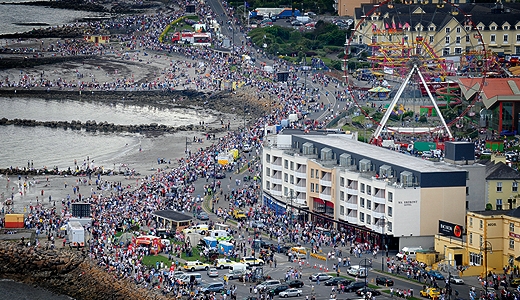Displaying items by tag: magheramore
Casting a Fly over Sailing Club Memberships
Some boating clubs might be feeling the pinch but not all of them. As Magheramore reveals there is one club with two dozen boats freely available for 400 members to use on a 'first come first served' basis. It is a budget model Irish sailing clubs might do well to study.
There is a club a few miles from the capital that owns 25 boats. These boats are freely available to all 400 club members at any time during the season. The rules are simple; no pre-booking, first-come-first-served, boats are signed out and signed back in, and any damage must be reported. This system has worked well for over 70 years!
Maintenance is carried out by members during off-season work parties. However, little work is actually needed. The boats are tough, fittings are robust, so that the only work needed is a coat of wood preserver on the thwarts and rubbing strakes, and the odd touch up to the gel-coat. It should be pointed out that these are standard boats, not beefed-up "club" versions. Boats are replaced at the rate of about one or two boats per year. The older boats are usually sold off to club members.
The fleet has been built up over the years. Both increased numbers of boats, and renewal of the fleet are financed out of club subscriptions., which are modest to say the least. This year, adult membership is only 55 euro!
The club does not run a bar, but there is a comfortable club room for meetings, or waiting for the rain to pass over.
Unsurprisingly, with membership limited by the lease at 400 adult members, there is a long waiting list. However, the club handles this waiting list in exemplary fashion. Children of members, if they have joined as junior members, automatically become full members after they reach 18. Prospective new members must apply. Applications to join the waiting list are only possible when the committee decides that all on the current waiting list are about to be admitted to the club. After a short application period (which tests potential members integration into local networks as they have to learn that the list is open) the names of all applicants are put into a hat, the first name drawn is first on the waiting list.
It can take some years to be offered membership, depending on turnover, as members leave, or forget to renew. The membership secretary is ruthless when it comes to the due date for annual subscriptions. It is no good bringing out the traditional excuses – the cheque may be in the post, but your membership has gone, and you must re-apply.
This description may sound to good to be true. Yet this club has been operating on the same basis for over 70 years. One might ask why national sailing organisations, the yachting press and other clubs are not promoting this model of club organisation. The answer is simple: did I ever say this was a sailing club? In fact it is an angling club, exclusively dedicated to fly-fishing for trout in a series of lakes not that far from Dublin.
This is yet another example where different groups who all believe, in their own way that "there is nothing – absolutely nothing – half as much worth doing as simply messing about in boats", seem to have little or no contact. Yet we all have much to learn, and we may have more in common than we think. The club I have presented here has solved, in its own way, the problem of how to get on the water without owning a boat.
Personally, I would welcome the idea of a sailing club with a fleet of robust but fun boats freely available to members. Membership might be slightly more than 55 euro per year, but it would be interesting to study the economics of such a structure. As it is, we seem to be settling in to a long period in which many sailors will not be envisaging buying a new boat, or indeed any boat. – Magheramore
How Can Clubs Cash in on Sailing's Spectator Appeal?
#SAILING – Can sailing be a spectator sport for a live audience or for direct transmission on television? Magheramore says it is already happening but the challenge is for clubs and classes to find a way to capitalise on the enthusiasm already generated on professional sailing circuits.
Two recent announcements have made this question of particular interest at the moment: the announcement of the course for the next America's Cup and the RYA Tribunal report effectively closing the "Ainslie" affair.
The 34th America's Cup will effectively take place in a nautical stadium along the San Fransico waterfront, with spectators being able to follow the whole race from the shore.
This is good news for owners of any property with a view over the bay. Purists, amateurs of the classic windward-leeward form of match racing may be less pleased.

The new San Franciso 'stadium' for the 2013 America's Cup
Two issues did not come to the fore in the heated discussions concerning Ben Ainslie's "frank discussion" with a camera boat driver. Firstly, the race course was placed close to the shore for the benefit of spectators, in an area where sea patterns were already disturbed as waves reflected off the breakwaters.
Secondly, this was no rogue cameraman and driver. They were media contracted by ISAF to provide television images at events organised by our sport's governing body.
The truth is that sailing is already a spectator sport. Many participants, including Ben Ainslie, and their support teams, earn a living as a result. Their lifestyle (which may not always be opulent) is funded by revenue generated by the sale of images which provide the basis of most sponsorship deals. If nobody gets to see the racing (either directly or though reports, resumes or pictures) then that revenue will disappear. ISAF has been told clearly that either sailing gets screen time or it will be out of the Olympics. Without the revenue generated by the Olympics many national sailing federations will be in financial trouble.

Schull in West Cork turns out for the 2011 ISAF Team Racing World Championships. Photo: Brian Carlin
Some sailing events are naturally spectacular and spectator friendly. Any of you who have witnessed the knock-out rounds of the Wilson Trophy, Europs's premier team racing event, will know what I mean. The course is no bigger than a football pitch, with boats sailing to within a few metres of the packed grandstand. Teams are clearly identified by coloured hulls and sails, with crew assigned to specific boats. In this way the team of commentators know who is in each boat. The running commentary keeps the somewhat partisan crowd fully informed. The atmosphere resembles the famous chariot race scene from Ben Hur. Nothing in Olympic sailing is as exciting and as perfect for television.
Other events are specifically organised to attract spectators and media. The French oceanic races are an example. The media build up can last a week or more, with radio and TV brodcasting live from the quayside. The sponsors of the event and the competing boats vie with each other to attract the attention of the thousands of visitors who come to see the boats, meet the sailors be entertained, and, this is France after all, fed. Sponsorship is facilitated by tax arrangements so that even quite small companies can get involved. The investment in a boat and crew is worthwhile as sailing, and especially the big races, are one of the most televised sports.
The start of a race will, of course, be timed so that the last few minutes before the gun can be shown live on the midday news. The media is omnipresent – helicopters buzz overhead, motor boats flood the start area, whilst the more audacious photographers zoom around on jet-skis, with the camera attached to their helmet. A disparate fleet of spectator boats line up along the edge of the no-go zone; car ferries, tourist boats (the 3 course lunch is included), old gaffers, cruisers, RIBs... anything goes. The scene resembles the evacuation from Dunkirk (without the guns!). In the midst of all this, professional sailors try to manoeuvre their boats to the start line without damage to their own boats or the fleet milling around them.

Crowds turnout for the 2009 VOR in Galway. Photo: Rick Tomlinson
We all remember the Volvo in Galway. The French do this several times a year, forming the basis of a whole industry, from boat-builders and sailmakers to event organisers, coaches, journalists.
Professional sailors will increasingly have to realise that they are in the entertainment business. Their job is not to win races but to win prime time minutes and column inches for their sponsors. Events for professional sailors will be designed to be spectacular and television friendly. Some of these events, such as the next America's Cup, will bear little ressemblance to the racing that we, the recreational sailors, enjoy.
The challenge, for federations, clubs, classes and all sailors is how to harness the enthusiasm generated by the professional circuits to benefit sailing as a whole. – Magheramore





























































